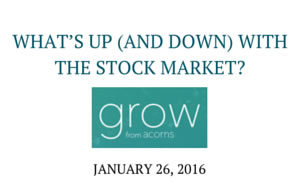What’s Up (and Down) With the Stock Market

Jan. 26, 2016
If you started investing for the first time within the last six years, you may have developed unreasonably optimistic expectations of the stock market. After all, from January 2009 through the end of last year, the Dow Jones industrial average more than doubled, and Standard and Poor’s 500-stock index increased by nearly 130 percent.
But, Debbie Downer moment: In case you haven’t noticed lately, stocks aren’t always so generous.
“Over these last six years of seeing the market steadily go up, a lot of us have forgotten that it’s normal for markets to also go down,” says Certified Financial Planner Stacy Francis, CEO of New York-based Francis Financial. “We forgot about the risks of investing.”
How kind of Mr. Market to remind us of those risks: Through Monday, January 25, 2016, the Dow has shed almost 1,264 points, or 7.4 percent, and the S&P 500 has stumbled more than 135 points, or 6.7 percent.
That puts the Dow at 15,885 (as of closing on January 25), or 13.4 percent below its 52-week high of 18,351—clearly in the midst of a market correction (defined as a reversal of at least 10 percent). On the bright side, we’ve got some ways to go before creeping into bear-market territory, as that’s typically defined as a decline of 20-plus percent. (To officially be in a bear market, the decline must hold steady across multiple indexes for at least two months.)
That’s probably left you wondering: What’s become of my upward-marching market?
A number of factors have contributed, including concerns about dropping oil prices, slowing growth in China and geopolitical tensions (among them, concerns over the Syrian civil war and refugee crisis and ISIS attacks). “These all come together and make what is a kind of a jittery market go ahead and see some pretty substantial losses,” says Francis.
Such serious problems with no easy solutions might make you think the market is forever doomed. But look at the big picture. Since 1926, we’ve seen a lot of bear markets, including S&P 500 drops of 44.6 percent in 1929, 61.8 percent in 1931-32, 48.2 percent in 1973-74 and (you might remember) 51.9 percent in 2007-08.
Still, over the entire time period from 1926 through 2013, the average annual return on stocks was 10.2 percent. In the worst year, stocks experienced a 43.1 percent loss; in the best year, a 54.2 percent gain. On the other end of the investing spectrum, the average annual returns on bonds since 1926 was just 5.5 percent on average, with a 32.6 percent gain in the best year and an 8.1 percent loss in the worst, according to Vanguard data.
“When you’re creating a plan for that mix of stocks and bonds, for the newer investor, it’s really powerful to see the relationship between adding more stocks—which adds to your return in the long term, but also adds to the risk—and the likelihood that you’re going to see many more ups and many more downs,” says Francis.
The numbers also show that, in the long run, stocks are a winning investment. It pays to stick with them. Still, seeing big losses jam-packed into a short timeframe can be unsettling.
“With the unprecedented volatility, we have seen in the markets over the past year, even experienced and patient investors are seeking pause,” says Frank Drago, senior vice president of Citizens Bank Investment Services. “Many small investors still typically sell at the bottom and buy in during periods that border on irrational exuberance.”
Indeed, data shows about a quarter of more than 360,000 investors who synched their portfolios with online tracker SigFig sold stocks when the Dow tumbled nearly 1,900 points in one dismal week last August. It seems logical, but it wasn’t. The market fully recovered those losses by mid-October—but the investors who cut and ran didn’t. Those who sold more than 30 percent of their stock holdings wound up losing 4.9 percent for the year compared to a loss of 2.6 percent for the median investor.
The lesson is clear: Don’t panic. If you have a good investing plan in place—meaning you have a well-diversified portfolio—stick with it through all the ups and downs.
Better yet, avoid paying attention to those ups and downs at all. “The people who are most likely to make these really big mistakes are those who are checking their accounts once or twice a day,” says Francis. “You have to understand that when you invest, it’s not just about today; it’s about five, 10, 20 years from now… How you invest impacts long term whether you’re going to reach your goals.”
Bottom line? Never let your emotions drive your decisions.
“Just like if there’s a winter storm, it doesn’t mean we’re all going to sell our houses and move to somewhere in Florida where they don’t get snow,” Francis says. “We’re rational; we know this is normal. That same approach needs to be part of investing.”
